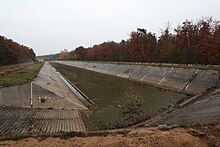Slow sand filters may be used where there is sufficient land and space as the water must be passed very slowly through the filters. These filters rely on biological treatment processes for their action rather than physical filtration. The filters are carefully constructed using graded layers of sand with the coarsest sand, along with some gravel, at the bottom and finest sand at the top. Drains at the base convey treated water away for disinfection. Filtration depends on the development of a thin biological layer, called the zoogleal layer or Schmutzdecke, on the surface of the filter. An effective slow sand filter may remain in service for many weeks or even months if the pre-treatment is well designed and produces water with a very low available nutrient level which physical methods of treatment rarely achieve. Very low nutrient levels allow water to be safely sent through distribution system with very low disinfectant levels thereby reducing consumer irritation over offensive levels of chlorine and chlorine by-products. Slow sand filters are not backwashed; they are maintained by having the top layer of sand scraped off when flow is e

ventually obstructed by biological growth.[citation needed]
A specific 'large-scale' form of slow sand filter is the process of bank filtration, in which natural sediments in a riverbank are used to provide a first stage of contaminant filtration. While typically not sufficiently clean enough to be used directly for drinking water, the water gained from the associated extraction wells is much less problematic than river water taken directly from the major streams where bank filtration is often used.



0 comments:
Post a Comment